This is the second part of a post on Shamim Momin’s talk on the work of Ellen Harvey, whose “Mirror” is now installed at the Pennsylvania Academy of the Fine Arts. Part one is here. For better representations than the slides herein, try this gallery site and Harvey’s web page.
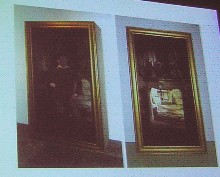 Momin continued: A painting makes a pretend window into another space. Instead Harvey made a 3-D painting, a framed view into a space that could be entered, behind the wall. Harvey’s subject here is about framing and desire (image, Harvey’s walk-ins).
Momin continued: A painting makes a pretend window into another space. Instead Harvey made a 3-D painting, a framed view into a space that could be entered, behind the wall. Harvey’s subject here is about framing and desire (image, Harvey’s walk-ins). At the Frankfort Art Fair in 2002, Harvey contributed a piece, “Not for Sale,” repainting directly on the wall a locally held and admired 1786 portrait of Goethe as well as painting a trompe l’oiel frame. To create a work that is not for sale, at an art fair, where sales and value are the main business, besides raising questions about value also asks what collectors want from a work of art (image, “Not for Sale”).
At the Frankfort Art Fair in 2002, Harvey contributed a piece, “Not for Sale,” repainting directly on the wall a locally held and admired 1786 portrait of Goethe as well as painting a trompe l’oiel frame. To create a work that is not for sale, at an art fair, where sales and value are the main business, besides raising questions about value also asks what collectors want from a work of art (image, “Not for Sale”).
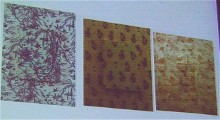 And in a 2003 art fair in Berlin, Momin said Harvey was even more biting, creating “Wallpaper for the Rich.” The wallpaper patterns she chose to paint and frame with more of itself were traditional patterns that suggested wealth. Momin said that Harvey was being true to her motto to “give everyone what they want.” Harvey is questioning the idea of what a painting is and whether it’s an outmoded medium, because it is no longer needed to serve the function of representing reality (image, “Wallpaper for the Rich”).
And in a 2003 art fair in Berlin, Momin said Harvey was even more biting, creating “Wallpaper for the Rich.” The wallpaper patterns she chose to paint and frame with more of itself were traditional patterns that suggested wealth. Momin said that Harvey was being true to her motto to “give everyone what they want.” Harvey is questioning the idea of what a painting is and whether it’s an outmoded medium, because it is no longer needed to serve the function of representing reality (image, “Wallpaper for the Rich”).
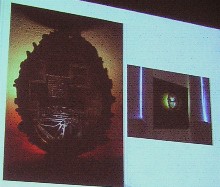 In “Welcome to my Home” (2005), Harvey scratched off the backing of a mirror to suggest the space behind, which she illuminated, in an inversion of what’s upstairs at PAFA. The piece suggests the the romanticism of personal biography and intimate access (image, “Welcome to my Home”).
In “Welcome to my Home” (2005), Harvey scratched off the backing of a mirror to suggest the space behind, which she illuminated, in an inversion of what’s upstairs at PAFA. The piece suggests the the romanticism of personal biography and intimate access (image, “Welcome to my Home”).
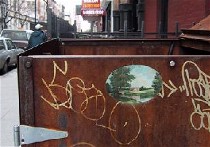 “The New York Beautification Project,” from 1999 to 2001, sponsored by Creative Time, was my personal introduction to Harvey’s work. In it, said Momin, Harvey repainted tiny versions of landscape paintings on discarded spaces–run-down urban zones. Harvey’s paintings are grafitti in this environment, and there’s a notion of performance and the amount of time invested in creating each of these projects, similar to the video part of the “Mirror” installation showing Harvey scratching the mirrors (image, one of Harvey’s landscapes on the side of a dumpster).
“The New York Beautification Project,” from 1999 to 2001, sponsored by Creative Time, was my personal introduction to Harvey’s work. In it, said Momin, Harvey repainted tiny versions of landscape paintings on discarded spaces–run-down urban zones. Harvey’s paintings are grafitti in this environment, and there’s a notion of performance and the amount of time invested in creating each of these projects, similar to the video part of the “Mirror” installation showing Harvey scratching the mirrors (image, one of Harvey’s landscapes on the side of a dumpster).
(By the way, this Wednesday at noon, Creative Time’s Peter Eleey will be speaking for another PAFA Art-at-Lunch program.)
Owners and police sometimes interrupted Harvey’s at work on this project, but once they saw what she was painting, they allowed her to continue, said Momin, because there’s a general acceptance of those types of images, as opposed to more traditional grafitti. Momin told a story of Harvey telling a policeman that she got permission at a seance from the dead owner of the property she was painting. The policeman let her continue.
Many of the images have disappeared, but each one is represented in a postcard and a book tracks the entire process.
People asked Harvey to do them in their house. At the Whitney project, Harvey asked the guards which of the paintings they liked and went to their houses to make paintings for them.
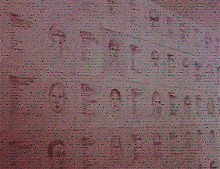 In “100 Free Portraits,” 15-minute sketches which Harvey drew in a city park, she was raising questions about who is considered a serious artist–Sunday painters? Street artists? After each drawing, she had the subject evaluate what they thought of her abilities. She exhibited the evaluations and the drawings in a gallery. Again time was a theme in this work (image, detail of installation of “100 Free Portraits”).
In “100 Free Portraits,” 15-minute sketches which Harvey drew in a city park, she was raising questions about who is considered a serious artist–Sunday painters? Street artists? After each drawing, she had the subject evaluate what they thought of her abilities. She exhibited the evaluations and the drawings in a gallery. Again time was a theme in this work (image, detail of installation of “100 Free Portraits”).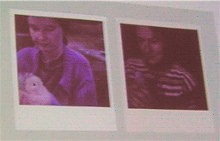 She continues to raise questions about what is real in “I See Myself in You,” paintings based on polaroids of herself as a child, but the paintings are really of her friends posing and dressed as the child in the polaroids (image, slides of two of “I See Myself in You” paintings).
She continues to raise questions about what is real in “I See Myself in You,” paintings based on polaroids of herself as a child, but the paintings are really of her friends posing and dressed as the child in the polaroids (image, slides of two of “I See Myself in You” paintings).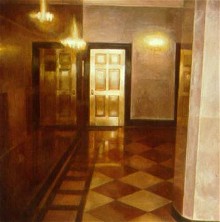 “Low Tech Special Effects” explores the role that painting used to play as they only way to see fantastical things happen (image, Harvey’s “Low Tech Special Effects: Heaven is a Doorman Building”).
“Low Tech Special Effects” explores the role that painting used to play as they only way to see fantastical things happen (image, Harvey’s “Low Tech Special Effects: Heaven is a Doorman Building”). 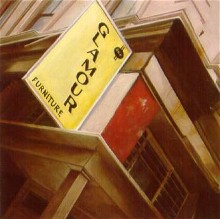 Again using Polaroids that she repainted she made images like “Earthquake,” in which she turned the camera sideways to create the effect, and “Heaven is a Doorman Building,” in which a lit-up door seems to emit a supernatural light–but it’s just a lit-up door in a luxury doorman building. In these pieces, she shows that the medium still retains this power to communicate fantastical happenings, said Momin(image, Harvey’s “Low Tech Special Effects: Earthquake”).
Again using Polaroids that she repainted she made images like “Earthquake,” in which she turned the camera sideways to create the effect, and “Heaven is a Doorman Building,” in which a lit-up door seems to emit a supernatural light–but it’s just a lit-up door in a luxury doorman building. In these pieces, she shows that the medium still retains this power to communicate fantastical happenings, said Momin(image, Harvey’s “Low Tech Special Effects: Earthquake”). 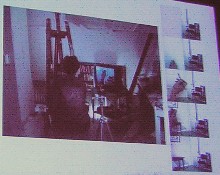 “Seeing is Believing” is a video of her painting, and although it looks as if she is painting an object before her, she is actually painting a videotaped object before her. Again, she is questioning reality, she is performing, she is contemplating time, and she is recreating a secondary source (image, slide of “Seeing is Believing”).
“Seeing is Believing” is a video of her painting, and although it looks as if she is painting an object before her, she is actually painting a videotaped object before her. Again, she is questioning reality, she is performing, she is contemplating time, and she is recreating a secondary source (image, slide of “Seeing is Believing”).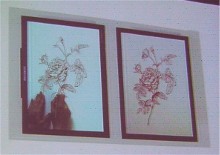 More recently, using video again to show her painting, she appears to be painting a rose on the wall using her own blood. The pieces raises a number of questions. Did she really cut herself? is she using real blood? or is it a joke on the stereotyped image of the suffering artist? The video is the same size as the actual piece (image, slide of “The Rose,” with left video of her hand creating the drawing that on the right).
More recently, using video again to show her painting, she appears to be painting a rose on the wall using her own blood. The pieces raises a number of questions. Did she really cut herself? is she using real blood? or is it a joke on the stereotyped image of the suffering artist? The video is the same size as the actual piece (image, slide of “The Rose,” with left video of her hand creating the drawing that on the right).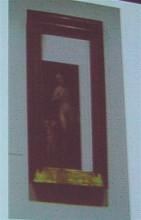 After her Whitney piece, Harvey did a piece for the Princeton Museum, “My Venus is Better Than Your Venus,” in which she painted a copy of a Venus and Adonis painting owned by Princeton on the wall. Because of Princeton’s rule required that reproductions of any work in the museum must be a different size than the original, Harvey’s Venus is smaller, but it’s surrounded by either the original frame or a reproduction of the original frame. Also, Harvey hung the original painting in her own home. A postcard is available of both Harvey’s version of the painting and the original version (image, slide of “My Venus…” installed).
After her Whitney piece, Harvey did a piece for the Princeton Museum, “My Venus is Better Than Your Venus,” in which she painted a copy of a Venus and Adonis painting owned by Princeton on the wall. Because of Princeton’s rule required that reproductions of any work in the museum must be a different size than the original, Harvey’s Venus is smaller, but it’s surrounded by either the original frame or a reproduction of the original frame. Also, Harvey hung the original painting in her own home. A postcard is available of both Harvey’s version of the painting and the original version (image, slide of “My Venus…” installed).The piece addresses the issues of desire for a piece in her own home and for the institution’s desire to preserve its authority. It’s also an institutional critique.
Other work she has done that links to the architectural piece at PAFA is a piece in Warsaw, in which she decorates hand-drawn architectural details like decorative moldings around the windows on a disused storage space in Warsaw. Unlike the castle across the street from it, the storage space was deemed unworthy of preservation and renovation. By adding her decorations, she is giving the building a historic pedigree. The piece is not about fooling the eye. The details are just outline drawings.









